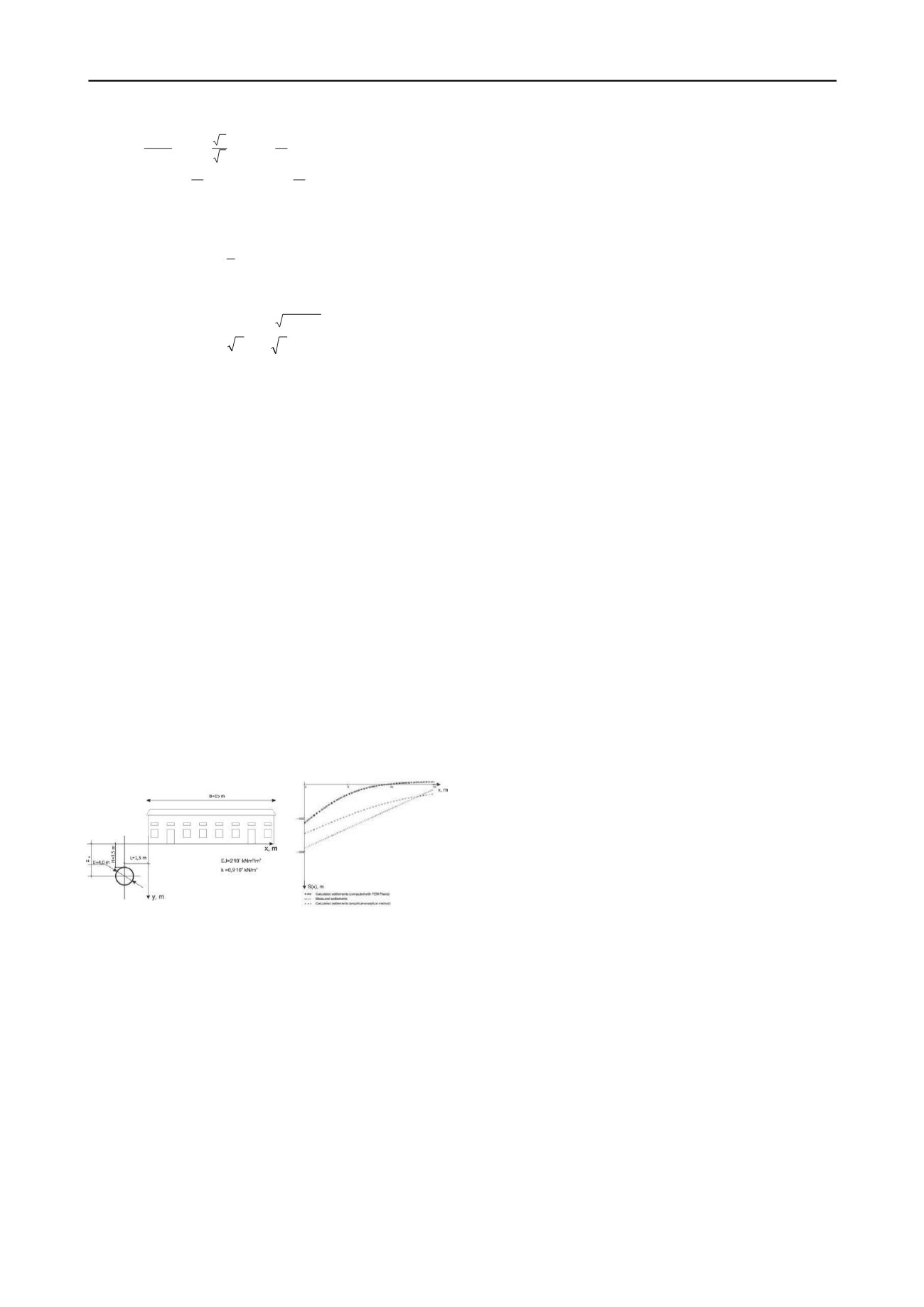
1726
Proceedings of the 18
th
International Conference on Soil Mechanics and Geotechnical Engineering, Paris 2013
(10)
The settlements of buildings of extended length, which are
situated at a certain distance from the axis of the tunnel are,
respectively
)
k
q )x(
( )x(S
II
II
II
(11)
The parameters of formula (11) are:
max v
SC
1
,
,
2
2
2
x
l /C
4
4
EJ /k
,
,
EJ /
A
3
1
81
EJ /
A
3
2
21
,
2
2
A k))
/(
(
II
,
) / (L x )x(N
II
2
2
,
)))) x(N sin( b ))x(N cos( a(
)x(N (cos
e )x(
II
II
II
)Lx(
II
where
a
and
b
are parameters for which we have compiled
tables of values as a function of
L
, β, and λ.
Similar results were obtainedfor an infinitebeam, that is, for
the building above thetunnel.
The values of
EJ
for buildings with a different number of
stories can be determined from recommendation of
Franzius and
Addenbrooke
(2002), and used for determination of the
influence exerted by the weight and stiffness of the building on
the settlement of the surface above the tunnel. Here, an
n
-story
building will c nsist of
n
+1 coverings.
o
The coefficient of subgrade reaction
k
is (0.3-0.9)
ڄ
10
4
when
E
< 10; (1-2.9)
ڄ
10
4
when
E
= 10-20; and (3-8)
ڄ
10
4
kN/m
3
when
E
=
21-35 MPa (Uhov et al. 1994).
Let us examine the single-story brick building of rectangular
planform at No. 31 Gruzinskii Street (Fig. 6).The utility tunnel
with
D
=4.0 m is being constructed by a Lovat RME 163 SE
tunneling unit. In the section under consideration,
H
=3.0 m, and
the load on the foundation
q
= 26 kN/m
2
. Plots of the building's
settlements, which were obtained by numerical modeling via the
PLAXIS 2D program in the plane statement using a Coulomb-
Mohr model, field data, and data determined from formula (11)
are presented in Fig. 6, b.
a)
b)
Figure 6. Diagram showing building and tunnel (a); building-
settlement plots (b): 1) computed settlements (PLAXIS method); 2)
computed deflections of beam (experimental-analytical method); 3)
measured settlements.
5 MEASURES FOR MODERNIZATION OF PROCEDURE
FOR OPENING SHALLOW TUNNELS
Different methods are employed to reduce the influence exerted
by the opening of tunnels on building settlements: installation of
cut-off walls, strengthening of the beds and foundations, and
also the superstructures of the buildings, compensation
injection, etc. In soils comprised of silty, saturated sands,
however, chemical stabilization above the tunnel does not
always yield positive results (for example, the collector along
the Gruzinskii Street line). Strengthening of the foundations
with piles is not always possible.
In addition to the existing protective measures, we are
proposing measures for modernization of opening procedures,
which are directed toward reduction of ground-surface and
building settlements. They include modification of the
properties of the grout injected into the space behind the lining;
reduction of the construction clearance that develops as the
shield is advanced; and, continuous pumping of the mixture in
the space behind the lining as the shield advances.
))) x
L sin( b)x
L cos( a(
x
L (cos
e
EJ
k )x(y
L x
II
2
2
2
3
2
1
2
1
2
1
4
Implementation of these measures on the construction
project for the collector along the Gruzinskii Street line has
resulted in a settlement reduction of up to seven times.
6 CONCLUSIONS
Rules are established for ground-surface deformation during the
opening of shallow utility tunnels.
Plots are presented for ground-surface deformations under
the geologic-engineering conditions of Moscow. The work zone
is defined in accordance with geotechnical monitoring.
A method is developed for prediction of building
settlements during the opening of shallow utility tunnels on the
basis of analytical solution of the problem of a beam on a
Winkler bed with an assigned support-lines displacement
describing the vertical displacements of the ground surface.
Formulas for determination of the settlements of the ground
surface and building during construction of shallow utility
tunnels can be used when
H
/
D
= 1-2.5.
Measures for modernization of the opening procedure, the
implementation of which has led to a seven-fold reduction in
settlements on a project, are proposed.
The
investigations
conducted
were
based
on
Recommendations (2007) (the work was performed by order of
the publicly owned joint-stock company Mosinzhproekt).
7 REFERENCES
PeckR.B. 1969.Deep excavation and tunneling in soft ground.State-of-
the-art report.
Proceedings of the Seventh International Conference
on Soil Mechanics and Foundation Engineering
, Mexico City, pp.
147-150.
Burland J.B., Standing J.R., and Jardine F.M. 2001.Building Response
to Tunneling.
Case Studies from Construction of the Jubilee Line
Extension
,
London
, Vol.
1
: Projects and Methods, Imperial College,
SIRIA, London, United Kingdom.
Clough G.W. and SchmidtB. 1981. Design and performance of
excavations and tunnels in soft clay,
Soft Clay Engineering
, edited
by E. W. Brand and R. Brenner, 569-634.
Moscow City Building Code 2-07-97
,
Beds, Foundations, and
Underground Structures
[in Russian], Moscow Government,
Moscow (1998).
N. S. Nikiforova 2008. Laws governing bed deformation of buildings
near deep trenches, and protective measures.
Author's abstract of
dissertation for Doctor of Technical Sciences
, Moscow.
Ilyichev V.А., Konovalov P.A., Nikiforova N.S., Tupikov M.M. 2009
Prediction of surface deformations, caused by shallow service
tunnels construction activities in Moscow.
Proc 17
th
International
Conference on Soil Mechanics and Geotechnical Engineering (17th
ICSMGE)
.-Egypt, Alexandria, 1993-1996.
Korenev B.G. 1954.
Analysis of Beams and Plates on an Elastic Bed
[in
Russian], Gosstroiizdat, Moscow.
Franzius J.N. and Addenbrooke T.I. 2002. The influence of building
weight on the relative stiffness method of predicting tunneling-
induced building deformation,
Proceedings of the Third
International Symposium (IS-Toulouse 2002) "Geotechnical
Aspects of Underground Construction in Soft Ground
,"
First
Session: Design Methods of Tunnels: Stability, Settlements, and
Tunnel Lining
s, Tolouse, France, 23-25 October 2002, 53-57.


